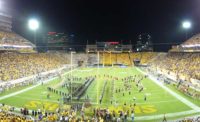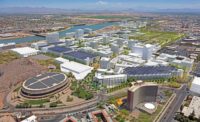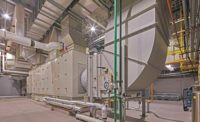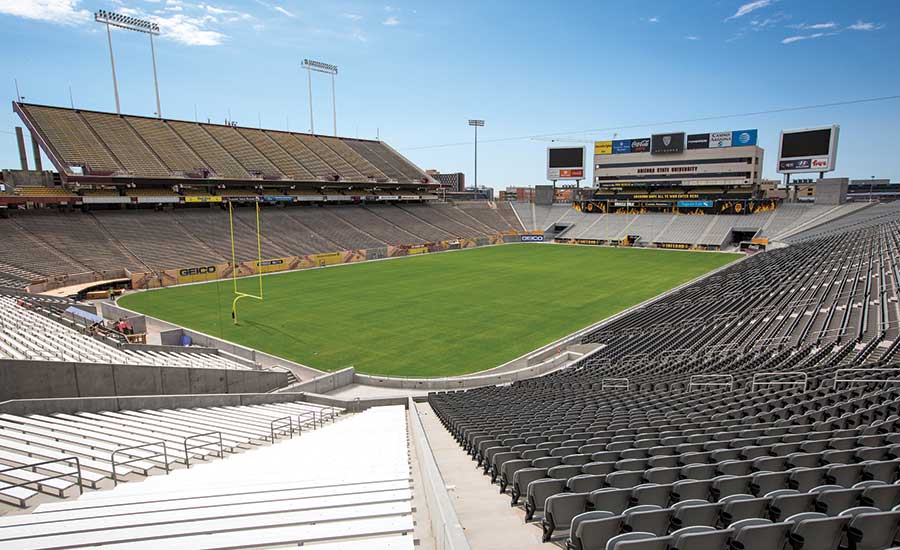Arizona State University Hires, Inspires Contractors

Sunlight reflects off copper panels on the nearly complete Biodesign C facility on ASU’s Tempe, Ariz., campus. When completed later this year, the facility will feature the first compact X-ray laser.
PHOTO COURTESY ARIZONA STATE UNIVERSITY

The $129-million, six-story, 280,000-sq-ft Beus Center for Law and Society | Sandra Day O’Connor School of Law in downtown Phoenix opened in 2016.
PHOTO COURTESY ARIZONA STATE UNIVERSITY

Sun Devil Stadium in Tempe, Ariz., has been undergoing improvements and renovation between football seasons since 2014. The $300-million project will be complete later this year.
PHOTO COURTESY ARIZONA STATE UNIVERSITY



Arizona State University earned recognition as ENR Southwest’s Owner of the Year for the quantity and scope of its construction projects as well as for its leadership in promoting innovative construction and design strategies.
“We love the challenge of accomplishing something new, and ASU projects always give our teams the opportunities to work in partnership with design teams and ASU stakeholders to push innovation,” says Matt Richards, project executive, Okland Construction.
ASU ranks as one of the nation’s largest public universities by enrollment, with five campuses in the Phoenix metropolitan area. It also operates several regional learning centers. Enrollment in 2017 was about 72,000.
But more significant than its size is the school’s dedication to innovation in how it plans and delivers projects. Earlier this year, the university captured its third straight No. 1 ranking in U.S. News & World Report’s Most Innovative Schools in America rankings, an award not just limited to academics.
Justin Kelton, president of McCarthy Building Cos.’ Southwest division, says ASU’s commitment to innovation in turn impacts how the construction industry does business in the state and region.
“Through their leadership they have been influential in making the construction industry better,” says Kelton.
Richards agrees, adding that when the university finds a better way to build facilities, it creates “ripple effects through the entire construction industry in Arizona.”
Big School, Big Projects
Bruce Nevel, chief facilities officer at ASU, says leading the way in green building is one of the hallmarks of the school’s construction strategy.
“We are very innovative at ASU as far as our approach toward construction,” Nevel says. “We look at development from a holistic perspective. There are obviously program needs to meet, but we also have ASU goals, one of them being net neutrality—so there is always a sustainability aspect to our projects.”
Of the university’s more than 25 million sq ft of buildings, about 4.3 million sq ft are LEED certified. Following a 2005 order from former Arizona Gov. Janet Napolitano that all buildings be at least LEED Silver when practical, ASU has completed 28 LEED-certified projects comprising 47 buildings since July 2006.
Nevel, who joined ASU in 2014 after serving as chief operating officer in the U.S. Naval Facilities Engineering Command Southwest in San Diego, says recent development success comes from the top-notch internal teams that do the work each day.
“Another thing that is very helpful is how we organize the construction side,” he says. “We have put together teams where the design manager is tied at the hip from early on with the project manager.”
Monica Perrin, ASU project manager, says quality individuals in construction, facilities, architecture and engineering make it easier to create successful projects that end-users appreciate as well.
“There are a group of people in this department that are not only educated in their various fields, but we also have a dynamic group of engineers and architects,” Perrin says. “The vast experience we have amongst the team is what lends us to be successful because we are able to work together and lean on each other.”
Nevel adds that ASU now has project execution teams assigned to some of the more active colleges on campus in order to develop a functioning relationship that builds and becomes stronger and more focused with each project.
“That has boosted the satisfaction of our [end-users], knowing that the conversations they have early on are going to be remembered for as long as the project takes,” Nevel says.
Notable recent projects include the $129-million, six-story, 280,000-sq-ft Beus Center for Law and Society | Sandra Day O’Connor School of Law in downtown Phoenix, which opened in 2016. Another is the $39-million, 75,000-sq-ft, Student Pavilion, the university’s first net-zero energy use building, which opened in late 2017.
ASU is currently in the midst of a $300-million rebuild of its football stadium and recently announced a $160-million rehabilitation of the Wells Fargo arena for the school’s basketball teams.
Nearly complete is Biodesign C, a 188,000-sq-ft, five-story building that will house the world’s first X-ray laser. Two laser-lab rooms have an isolated 4- to 6-ft mat-slab with 4-ft-thick concrete walls.
Kelton, whose firm built Biodesign C and many other ASU projects, says the school’s collaborative business model “promotes a win-win-win approach in the delivery of their projects.”
Conversely, Nevel says the university looks for construction partners it can rely upon.
“I make it a point to talk to our contractor partners to emphasize that what is important to me is the long-term relationships with our construction partners,” he says. “I am interested in them really knowing us and our needs.
“The folks that want to come in and make a quick buck, they are not going to get work with us,” Nevel adds. “For those who want to partner with us, there are opportunities.”







